OudSwede
Oud Addict
  
Posts: 43
Registered: 11-9-2020
Location: Sweden
Member Is Offline
|
|
Ideal string attachement for floating bridge ouds?
Hi!
I am currently making a floating bridge oud. As all such ouds its strings will be attached at the end/bottom of the oud. But what string attachment
method is the ideal? There are so many methods out there. Here are some that I have found. And, by the way, what is the proper name for this endpiece
of wood where the strings are attached? Endpiece?
The reasons for these differences are probably twofold: a) the original method sometimes makes the string ends to scratch the arm, b) aesthetics,
since there can be som many different ways to make details and also profile yourself as a luthier.
The first, and original concept was the Fadil invention of the floating bridge oud for Bashir. Here, the strings are attached just like a traditional
oud with twisted loops, but the end of the string is under the endpiece.

(Source: Oud Migrations)
Another version can be found by oud maker Imad Samra, who claims to be the inventor of it. The strings are attached with knots under the endpiece. The
endpiece is also integrated into the binding.

(Source: Facebook Imad Samra)
Yet another version, with an integrated endpiece:

(Source: Oudstrings.com)
Another example of an integrated endpiece (I merged two photos into one here)

(Source: Instagram Mahmoud Dagher)
The final example, at this time is this. Here the string is attached through a special loop (the string goes first over the endpiece, then under and
up in it, and over the string and back down). I do not know how its made. It seems, that the string is somehow inserted into the hole twice, but I
cannot understand how it is made possible with the wounded strings due to their thickness. Any clues? As far as I have found out, this idea comes from
saz-strings, but they are much thinner and have an end-loop where strings go through.
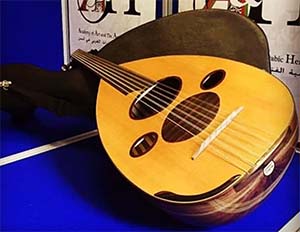
(Source: Instagram Hafezalsleman)
The Saz-strings attachement as reference

(Source: Amazon)
I have seen on guitars, that they sometimes utilize small beads to secure the string, has this been tested on an oud, or are only knots used?
Have you seen other versions (please submit pictures)? How are strings attached (ie how to change strings if is not obvious)?
What system do you prefer?
Kind regards,
Viktor
|
|
|
Ronny Andersson
Oud Junkie
    
Posts: 724
Registered: 8-15-2003
Location: Sweden
Member Is Offline
Mood: No Mood
|
|
The oud that Fadel built for Munir Bashir is influenced by the classical ¨Mandolino Napoletano¨ with its slightly bent soundboard that handles the
string tension with its floating bridge.
Many ouds today built with this concept ¨floating bridge¨ are reinforced much more than what Fadel did in 1957.
What one can note is that the majority of newer oud builders do not understand the benefit of the bent soundboard.
I myself have had several floating bridge ouds more or less well and some that can not handle the string tension and the soundboard collapses under
the pressure.
How the strings are attached is called ¨cordiera¨ in Mandolino Napoletano in english called ¨tail piece¨. This part performs no more function than
fixing the strings. Of course, you can discuss more about the bridge whether it should be in solid wood or with an edge made of bone.
I attach couple of pictures one of a oud by Munshed owned by me with a bridge designed by Dr Oud. Also a picture of my new oud I ordered this year
following the concept used by Fadel when he built the oud for Bashir in 1957. This maker is a professional luthier in Hungary.
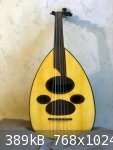
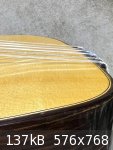
Best wishes
Ronny
|
|
|
Ronny Andersson
Oud Junkie
    
Posts: 724
Registered: 8-15-2003
Location: Sweden
Member Is Offline
Mood: No Mood
|
|
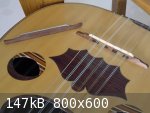
Best wishes
Ronny
|
|
|
OudSwede
Oud Addict
  
Posts: 43
Registered: 11-9-2020
Location: Sweden
Member Is Offline
|
|
Hi!
Thanks, Ronny, for the comments and pictures! Most interesting regarding the necessity of a bent soundboard. That reminded me of a repair project I
had some time ago of specifically a Napolitan mandolin. Here are some pictures of the backside of the soundboard and the slope. The soundboard is bent
twice: in a curve over the brace, and sloping after the last brace. In order to achieve this latter slope, the soundboard is cut halfway through. This
cut is not visible on the outside. Are the same methods used for a floating bridge oud?
The last picture is of the repaired mandolin where the sloping soundboard is visible. The endpiece is in steel, as custom here.
Does anyone else have pictures of different tailpieces? I guess that is better than endpiece? Does anyone know what it is called in arabic?
Kind regards,
Viktor
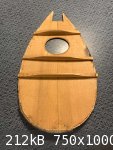
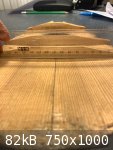
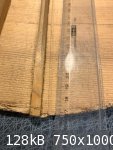
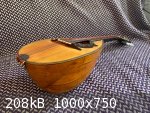
|
|
|
Ronny Andersson
Oud Junkie
    
Posts: 724
Registered: 8-15-2003
Location: Sweden
Member Is Offline
Mood: No Mood
|
|
There seem to be few of his ouds with this typical ¨cut¨ made by Fadel. The majority of his floating bridge ouds are without this typical detail and
he seems to have abandoned this quite early and instead changed the string action and the angle of the bowl.
Can not answer with its pros and cons but definitely the sound in these ouds is easy to identify. A friend owns an original Fadel Bashir model from
1983 and differs from in string action and the angle of the bowl/soundboard.
My new oud Bashir model made in Hungary sounds very good and I have always used the A415 when the majority of older instruments sounds much better
than then in modern pitch.
That Bashir had problems with the bridge on his traditional oud is due to humidity and hide glue that was used.
This reminds me of the sensitive Renaissance lutes of the past that had a limited lifespan.
First picture Bashir original -57. The one from -59 without the ¨cut¨.
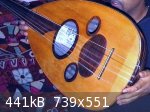
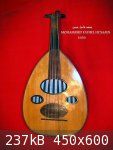
Best wishes
Ronny
|
|
|
Ronny Andersson
Oud Junkie
    
Posts: 724
Registered: 8-15-2003
Location: Sweden
Member Is Offline
Mood: No Mood
|
|
Forgotten this one.
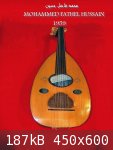
Best wishes
Ronny
|
|
|
Ronny Andersson
Oud Junkie
    
Posts: 724
Registered: 8-15-2003
Location: Sweden
Member Is Offline
Mood: No Mood
|
|
https://youtu.be/uQobvrWgEz4
Best wishes
Ronny
|
|
|
OudSwede
Oud Addict
  
Posts: 43
Registered: 11-9-2020
Location: Sweden
Member Is Offline
|
|
Thanks a lot, Ronny!
(And since we both speak Swedish: tack så jättemycket för bilderna!!!)
/Viktor
|
|
|